
USS Lassen (AE-3) was built as MS Shooting Star under a U.S. Maritime Commission contract, was delivered to the U.S. Navy after sea trials, and became an ammunition cargo ship during World War II. Like many Naval ships of this category that carried large amounts of explosive cargo, she was named for a volcano. In this case, the ship was named for Lassen Peak, a volcano in northern California that erupted heavily in 1914–17.

The fourth USS Vesuvius (AE-15) was laid down under a Maritime Commission contract by the North Carolina Shipbuilding Company, Wilmington, N.C.; launched on 26 May 1944; acquired by the United States Navy on 4 July 1944; and commissioned on 16 January 1945.

USS Haskell (APA-117) was the lead ship of her class of attack transports, built for the United States Navy during World War II. She was of the VC2-S-AP5 Victory ship design type. Haskell was named for the Haskell Counties of Kansas, Oklahoma, and Texas.

USS Salem (CM-11) was a commercial cargo ship, that served as a minelayer and then net laying ship of the United States Navy during World War II.
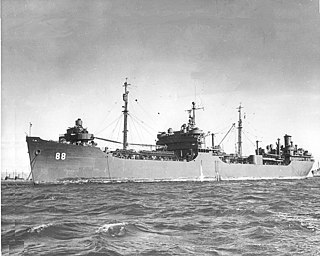
USS Tomahawk (AO-88) was an Escambia-class fleet oiler acquired by the United States Navy for use during World War II. She had the dangerous but necessary task of providing fuel to vessels in combat and non-combat areas primarily in the Pacific Ocean. For her valiant efforts, she received six battle stars during the war.
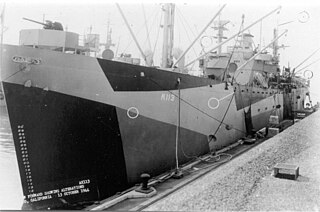
USS Rutilicus (AK-113) was a Crater-class cargo ship commissioned by the US Navy for service in World War II. She was responsible for delivering troops, goods and equipment to locations in the Asiatic-Pacific Theater.

USS Lesuth (AK-125) was a Crater-class cargo ship commissioned by the US Navy for service in World War II. Lesuth was named after the star Lesuth in the constellation Scorpius. She was responsible for delivering troops, goods and equipment to locations in the Asiatic-Pacific Theater.

USS Megrez (AK-126) was a Crater-class cargo ship commissioned by the US Navy for service in World War II. Megrez was named after Megrez, a star in the constellation Ursa Major. She was responsible for delivering troops, goods and equipment to locations in the Asiatic-Pacific Theater.
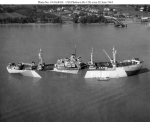
USS Phobos (AK-129) was a Crater-class cargo ship commissioned by the U.S. Navy for service in World War II. She was responsible for delivering troops, goods and equipment to locations in the war zone.

USS Ascella (AK-137) was a Crater-class cargo ship commissioned by the US Navy for service in World War II. Ascella was named after Ascella, a star in the constellation Sagittarius. She was responsible for delivering troops, goods and equipment to locations in the Asiatic-Pacific Theater.
USS Pavo (AK-139) was a Crater-class cargo ship commissioned by the U.S. Navy for service in World War II, named after the constellation Pavo. She was responsible for delivering troops, goods and equipment to locations in the war zone.

USS Brevard (AK-164) was an Alamosa-class cargo ship commissioned by the U.S. Navy for service in World War II. She was responsible for delivering troops, goods and equipment to locations in the war zone.
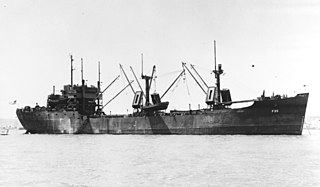
USS Latona (AF-35) was an Adria-class stores ship in service with the United States Navy from 1945 to 1949. She was scrapped in 1973.

USS Boulder Victory (AK-227) was a Boulder Victory-class cargo ship acquired by the US Navy during World War II. She was the lead ship of 20 ships in her class. She carried ammunition into the Pacific Ocean war zone and, on 20 December 1944 at Manus Island, New Guinea, she struck a naval mine and suffered a very large hole in her side.

USS Las Vegas Victory (AK-229) was a Boulder Victory-class cargo ship acquired by the U.S. Navy during World War II. She served in the Pacific Ocean theatre of operations through the end of the war earning one battle star, and then returned to the United States for disposal.
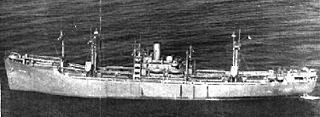
USS Manderson Victory (AK-230) was a Boulder Victory-class cargo ship acquired by the U.S. Navy during World War II. She served in the Pacific Ocean theatre of operations through the end of the war, earning one battle star, and then returned to the United States for disposal.
USS Bedford Victory (AK-231) was a Boulder Victory-class cargo ship Victory ship acquired by the U.S. Navy during World War II. She served in the Pacific Ocean theatre of operations through the end of the war, earning one battle star, and then returned to the United States for disposal.

USS Mayfield Victory (AK-232) was a Boulder Victory-class cargo ship acquired by the U.S. Navy during World War II. She served in the Pacific Ocean theatre of operations through the end of the war and then returned to the United States for disposal.
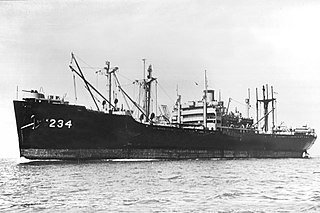
USS Bucyrus Victory (AK-234) was a Boulder Victory-class cargo ship acquired by the U.S. Navy during World War II. She served in the Pacific Ocean theatre of operations through the end of the war, earning one battle star, and then returned to the United States for disposal.

USS Lakewood Victory (AK-236) was a Boulder Victory-class cargo ship acquired by the U.S. Navy during World War II. She served in the Pacific Ocean theatre of operations through the end of the war, earning two battle stars, and then returned to the United States for disposal.

















